Decision-making module
This module is designed to provide information to users making decisions in difficult conditions for a complete and objective analysis of the road situation. The purpose of this module is to assist users in making decisions, for example, informing external systems about an event or incident and transmitting data about the event or incident to external systems.
The modules provides:
- Event processing
- Information related to an event registered in the System in the event card.
- Photos and videos from a camera on the section of the road where the event occurred.
- The option for reproducing (play) an event in the graphical configurator (except for events identified by indirect evidence).
Event to process
The Modal window Event to process is an event processing window. It gives brief information about the event and enables the operator to change the event status and go to the Event Card window.
You can go to modal window Event to process by clicking on the icon on the top panel Notification of a recorded event. The number of events to process is indicated in parentheses at the top of the modal window.
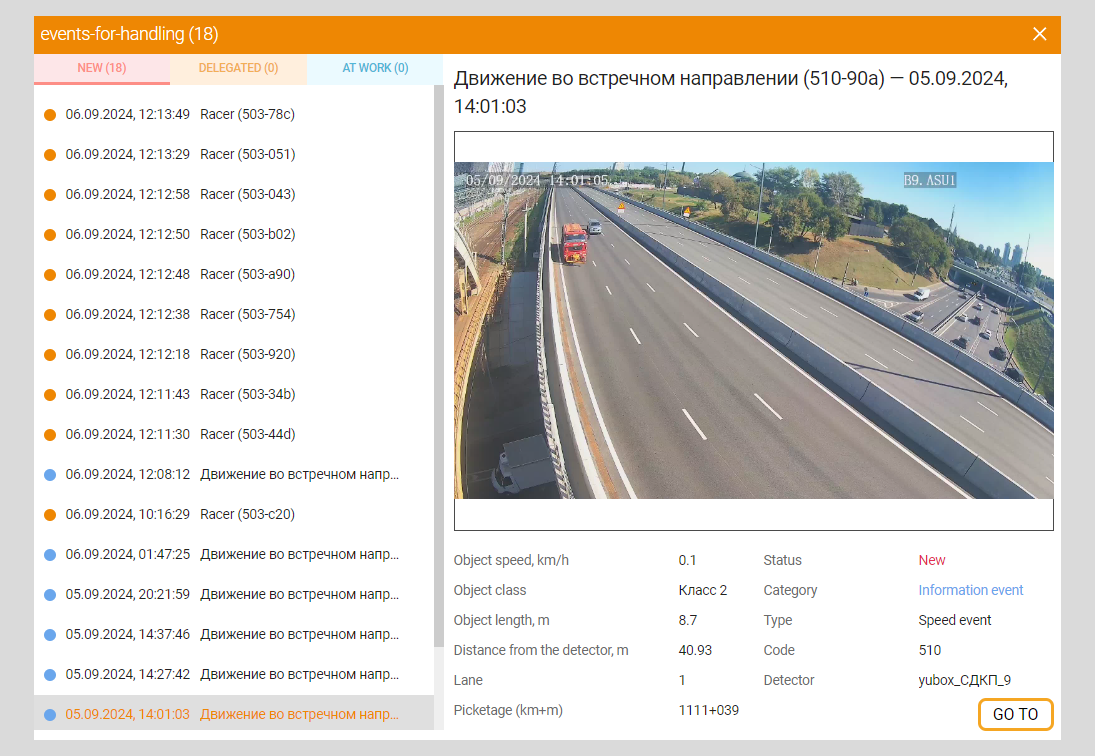
In the next table the Parameters of the Events for processing modal window are described
| Parameter | Description |
|---|---|
| New | New event for operator processing |
| Delegated | Delegated event for operator processing |
| In progress | Events that the operator is working on |
| Rule name | Name of the event rule, captured event |
| Time and date | Date and time of the recorded event |
| Block with media data | Photo or video file of the event |
| Object speed, km/h | The speed of the object at the time of the event |
| Object class | Class of the object participating in the event |
| Object length, m | Length of the object participating in the event |
| Distance from detector, m | Distance from the detector at the time of the event |
| Band | The bar on which the event was recorded |
| Picketage (km+m) | Picketing before the event |
| Status | Log status for this event |
| Category | The field displays the category of this event to the user: - Information - Warning - Critical Event |
| Type | In the drop-down list, the user is shown a list of event types registered in the system: - Speed events - Traffic events - Other events |
| The code | Unique event code assigned in the System |
| Detector | Detector name |
| Go button | Click to go to the card of the selected event |
| Close button | It is used to close modal window |
Event card
This functionality is being developed currently
The Page Event Card contains information with data on the selected event in the list of all project events. When you click on an event in the list, the card of the selected event opens. The event card also contains photos and videos from the nearest camera and a link to go to the graphical configurator to play the event.
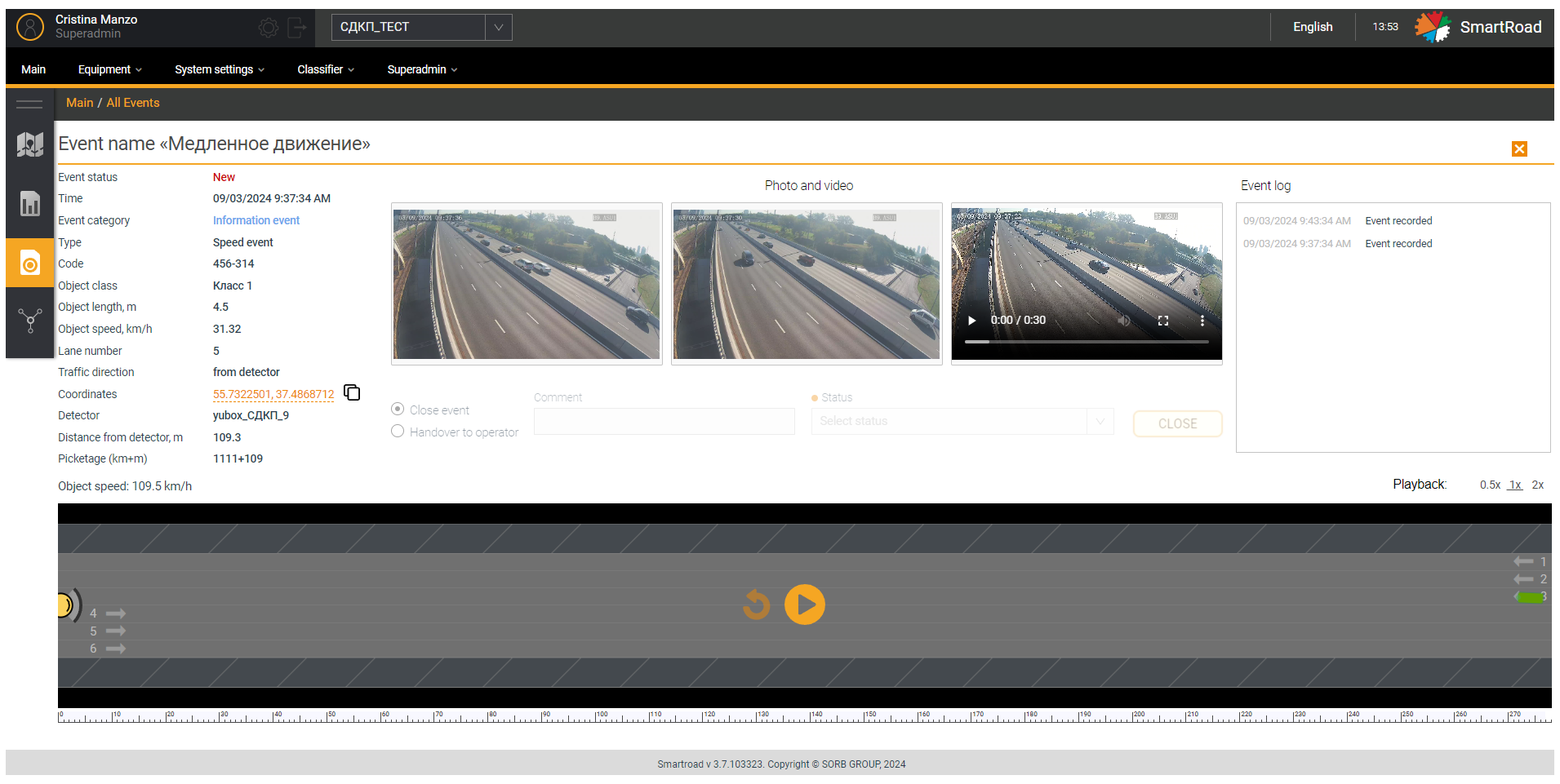
In the table below you can find the Event card parameters
| Parameter | Description |
|---|---|
| Event name | Event name specified in the System |
| Status | Event status |
| Time | Event start date and time |
| Event category | The category of this event is displayed to the user in the field |
| Event type | The field displays to the user the type of this event and the last three characters of the event id |
| The code | Event code, which consists of the event rule code |
| Object class | Object class registered in the System |
| Object length, m | The field displays to the user the length of the object participating in the event in meters. |
| Object speed, km/h | Speed of the object participating in the event |
| Lane number | The field displays to the user the value of the lane number on which the event occurred. |
| Direction of movement | Direction of traffic on this lane |
| Coordinates | Coordinates of the registered event |
| Detector | Name of the detector that recorded the event |
| Distance from detector, m | Distance from the detector that recorded the event |
| Picketage (km+m) | Picketing before the event |
Besides, Photo and video parameter types
| Item type | Description |
|---|---|
| General panoramic photo from the camera | The field displays to the user a general panoramic photo obtained from the camera |
| Close-up photo from camera | In the field, the user is shown an approximate photo obtained from the camera |
| Live camera video | The field displays video from the camera in real time to the user |
The Radio button Close event parameters
| Parameter | Description |
|---|---|
| A comment | A comment for the event is entered in the field. The user must click on the button Close to save a comment in the event card. |
| Status | The field displays to the user a drop-down list of event status: - Confirmed - False alarm - Classification error Pause in work |
| Close | When you click the button, the event is closed |
The Radio button Transfer to operator parameters
| Parameter | Description |
|---|---|
| A comment | A comment for the event is entered in the field. The user must click on Submit button to save a comment in the event card |
| Pass to user | The field displays a drop-down list of operator names to which the event can be passed |
| Hand over | When you press the button, the event is transmitted to another operator |
The Block Processing log parameters
| Parameter | Description |
|---|---|
| date and time | Date and time of log status change |
| Status Log (First Name, Last Name) | List of statuses of all logs for a given event indicating operators |
Finally, the Multiplayer to replay the event parameters
| Parameter | Description |
|---|---|
| Playback 0.5x,1x,2x | The field displays to the user the name of the lane type where the event occurred |
| Play events in the graphical configurator | In multiplayer, the event is played back. |
| Close card | Clicking the button closes the event card window |
Event Rules
Sub-item of the top menu of the System Settings section Event Rules is intended for setting up rules for registering events in the System. On the page Event Rules the user has access to a filter for searching rules and a list of rules created in the System.
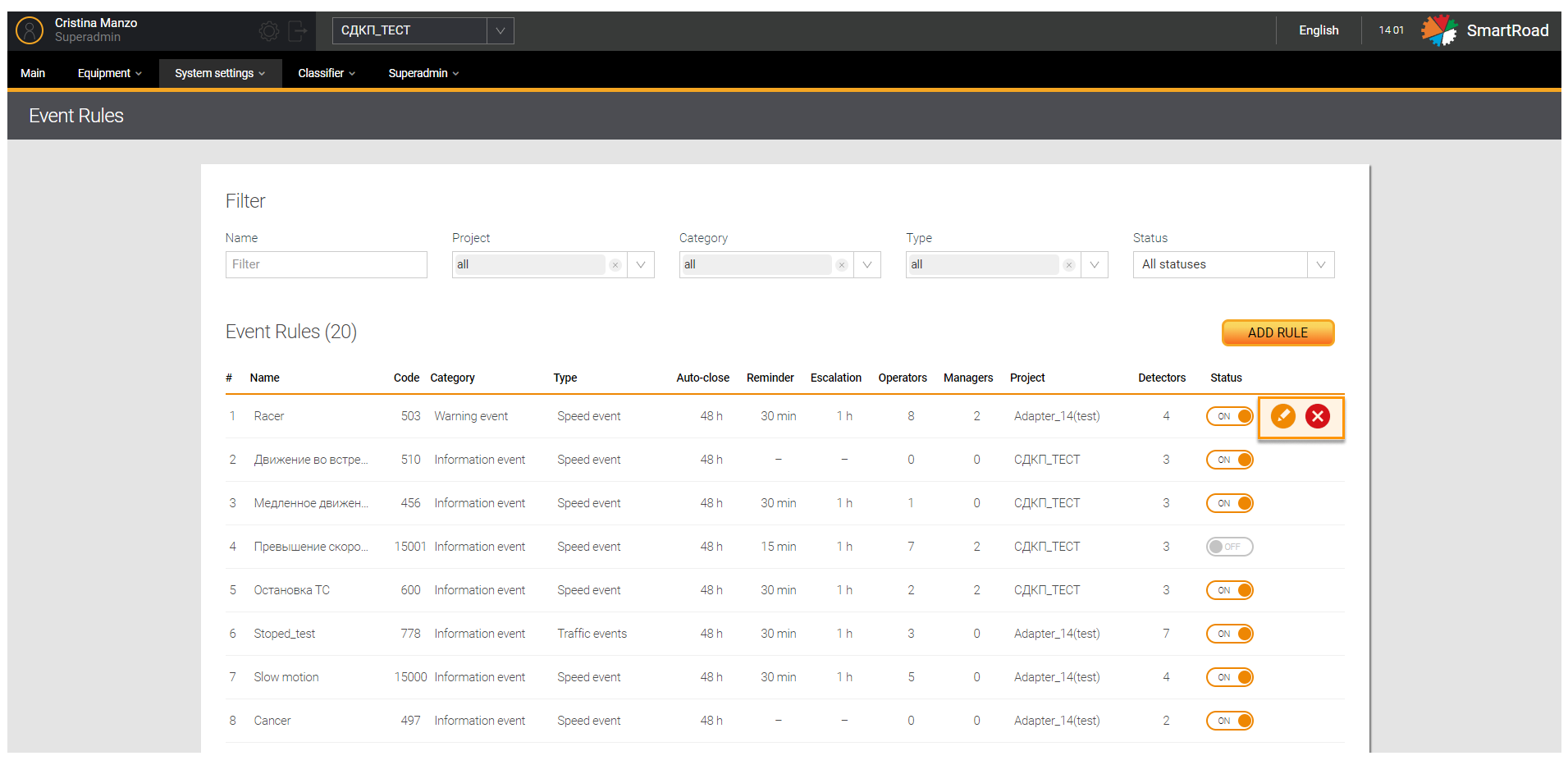
In the table below you can find the Event rule filter parameters
| Parameter | Description |
|---|---|
| Name | The field indicates the name of the event rule specified when registering the rule |
| Project (multiple choice list) | In the drop-down list the projects registered in the System are displayed to the user. The choice is made by checking the checkbox. By default, all list items are selected. |
| Category (multiple choice list) | In the drop-down list, a list of event categories registered in the system is shown to the user: - Information - Warning - Critical event |
| Type (multiple choice list) | In the drop-down list, a list of event types registered in the System is shown to the user: - Speed events - Traffic event - Other events The choice is made by checking the checkbox. By default, all list items are selected. |
| Status | In the drop-down list, a list of event statuses is displayed: - All statuses - Active - Inactive. |
Furthermore, Parameters of the Event Rules list
| Parameter | Description |
|---|---|
| # | The serial number of the entry in the list |
| Name | Event rule name specified when adding the rule |
| The Code | Unique event rule code specified when registering the rule in the System |
| Event category | Event category: - Information - Warning - Critical event |
| Event type | Event types: - Speed events - Traffic events - Other events |
| Auto close | The period of time after which the event will automatically close |
| Reminder | The period of time after which a notification is sent to the operator reminding about the event. |
| Escalation | If an event is not completed (unclosed) by the time of execution, an escalation notification is sent to the project manager after a specified period of time. |
| Operator | A user who has been granted the operator role to work with recorded events |
| Managers | A user who has been granted the manager role to escalate an issue that was not closed within the specified time frame |
| Project | Name of the project in which the rule is applied |
| Detectors | Number of detectors for which it is valid this rule |
| Status | A list of event statuses is displayed. The status is displayed as a switch. When you click the button, the status of the event rule changes to “inactive”. |
Adding an Event Rule
Adding a new rule to the System is done on the page Events by clicking the button Add rule. This will take you to the page Add Rule that enables to create a new rule in the System.
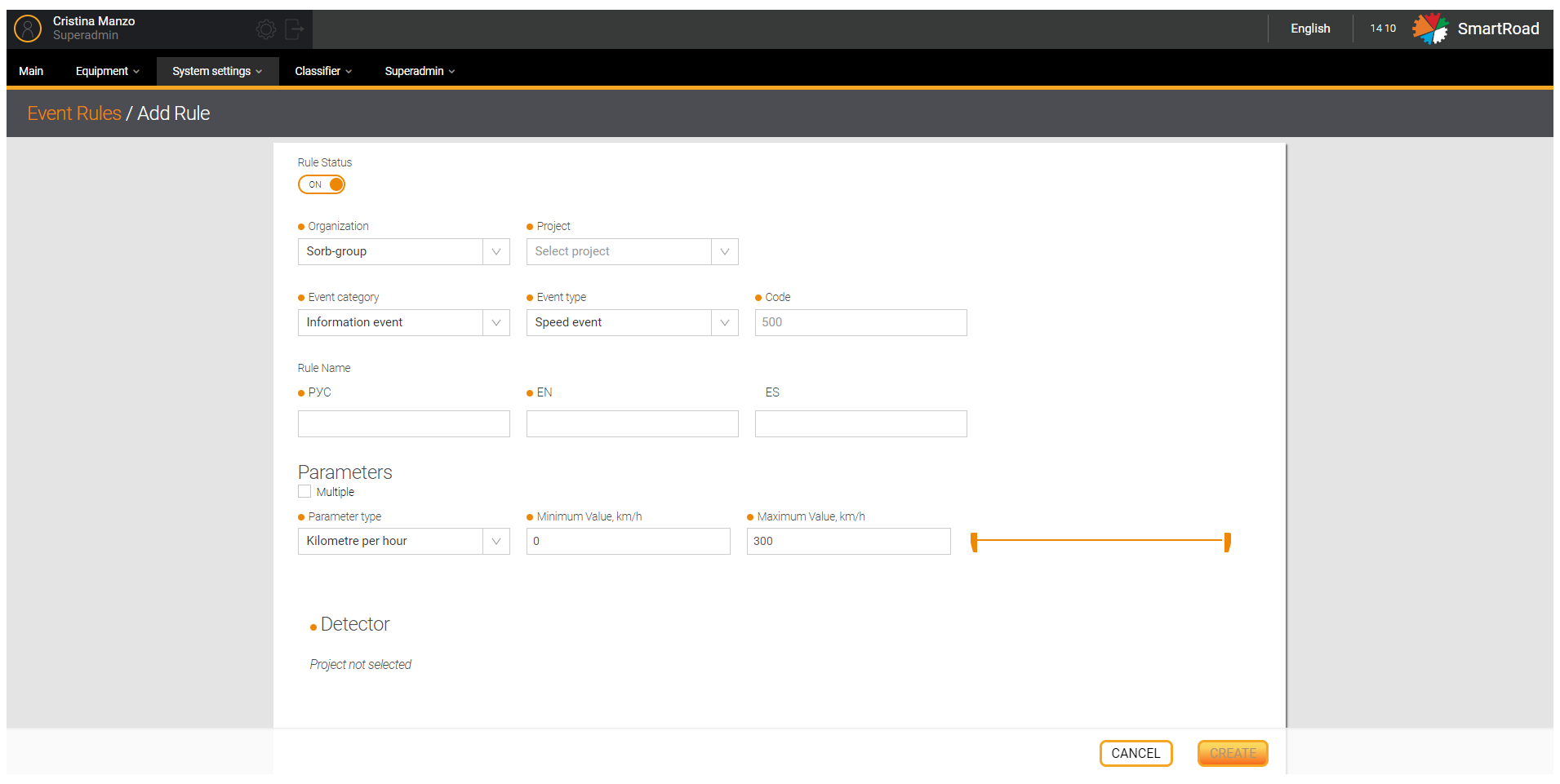
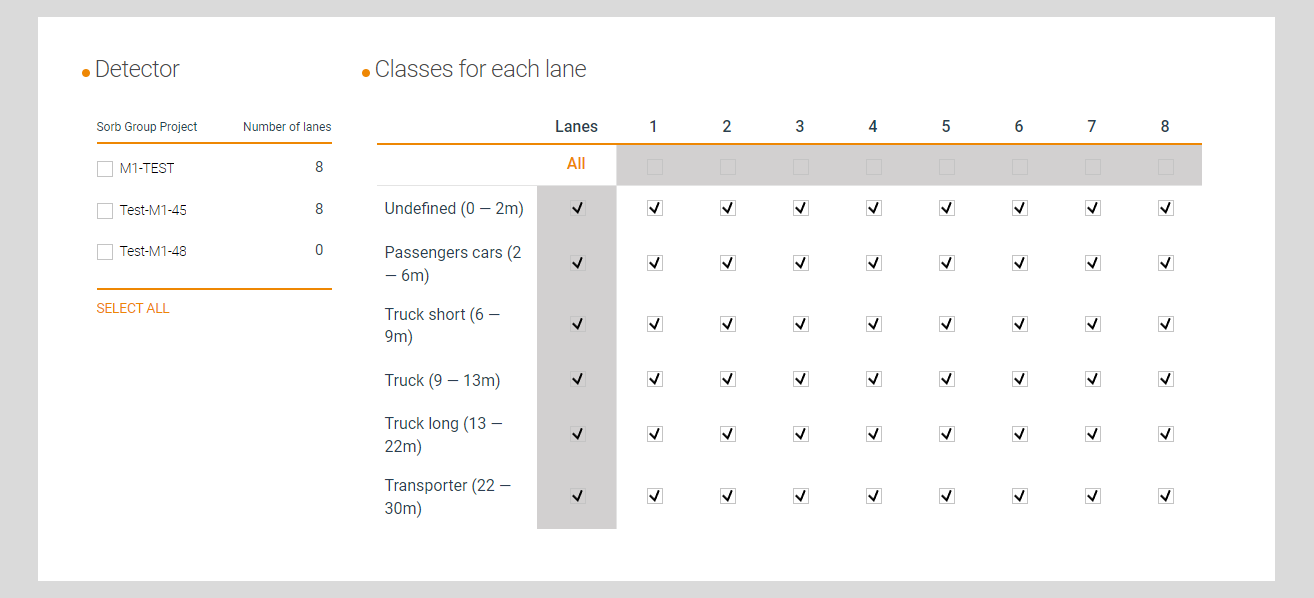
In the next table you can find the Options for adding a rule
| Field / button | Description |
|---|---|
| Rule status | The status is displayed as a button - switch. When you click on the icon, the status of the rule changes to “inactive” and the created rule is not applied in the System |
| Organization*/** | The drop-down list displays a list of organizations available for selection for which the rule will be created. This field is available only for Superadmin (i.e users with role Superadmin) |
| Project* | The drop-down list displays a list of projects available for selection within rule will be applied. This field is available only for Superadmin |
| Event category* | The drop-down list displays a list of selectable event categories for the rule: - Information - Warning - Critical event |
| Event type | The drop-down list displays the list of types available for selection: - Speed events - Traffic events - Other events |
| Code* | A unique rule code, which is independently specified by the user when registering the rule. If you try to create a code with an already registered number, a notification message will appear |
| Name of the rule (RUS)* | The name of the rule in Russian, which will be displayed in the System |
| Name of the rule (EN)* | The name of the rule in English, which will be displayed in the System |
| Rule Name (ES) | Custom rule name in Spanish language that will be displayed in the System |
Furthermore, you will have the following Options
| Item type | Description |
|---|---|
Checkbox Multiple | A checked checkbox indicates that several parameters have been selected for the rule. You can add a maximum of 5 types of parameters. |
| Parameter type | In the drop-down list, select the type of parameter that will be used to determine which parameter or unit of measure for event registration will be used in the rule: - Object in scope Kilometers per hour - - Meters per second - GAP - Headway - Wrong direction - Vehicle stop - Pedestrian detected - Custom Event |
| Minimum value | Minimum unit value (if available). The user can also specify the minimum value using a slider, located to the right of the field. |
| Maximum value | Maximum unit value (if available). The user can also specify the maximum value using the slider that is located to the right of the field. |
Besides, the fields and buttons
| Field / button | Description |
|---|---|
| Slider | It enables to change the minimum and maximum value of a quantity (It is available) |
| Close | Remove parameter type |
| Addition | Add an additional parameter type |
In case of detectors
| Item type | Description |
|---|---|
| Choose all | By checking the checkbox, you can select all detectors in the project to which the rule will be applied. |
| Checkboxes with detector names | The selection of detectors is carried out by installing or removing checkboxes. The checked checkbox is a sign of application of the rule for the detector |
Finally, the Classes for each band
| Item type | Description |
|---|---|
| Stripes | Select a band or all bands using the All button |
| Classes | According to the classes registered in this project, by default: - Undefined (undefined) – 0-2 m - Passenger cars (passenger cars) – 2-6 m - Truck short (short trucks) – 6-9 m - Truck (trucks) – 9-13 m - Truck long (long trucks) – 13-22m - Transporter (transport road trains) – 22-30 m |
| Save | A button that, when pressed, the system saves entered parameters and and creates a new rule |
| Cancel | A button that, when clicked, resets all entered parameters and cancels the creation of a new rule |
(*) - It is a mandatory field
(**) - It is available only for users with the Superadmin role
Fields whose values are entered incorrectly will be highlighted in red. The values in them need to be changed.
Setting up roles in the decision module
You should click on Add new rule and then in the list of rules press the edit button to configure or change roles in the event module.
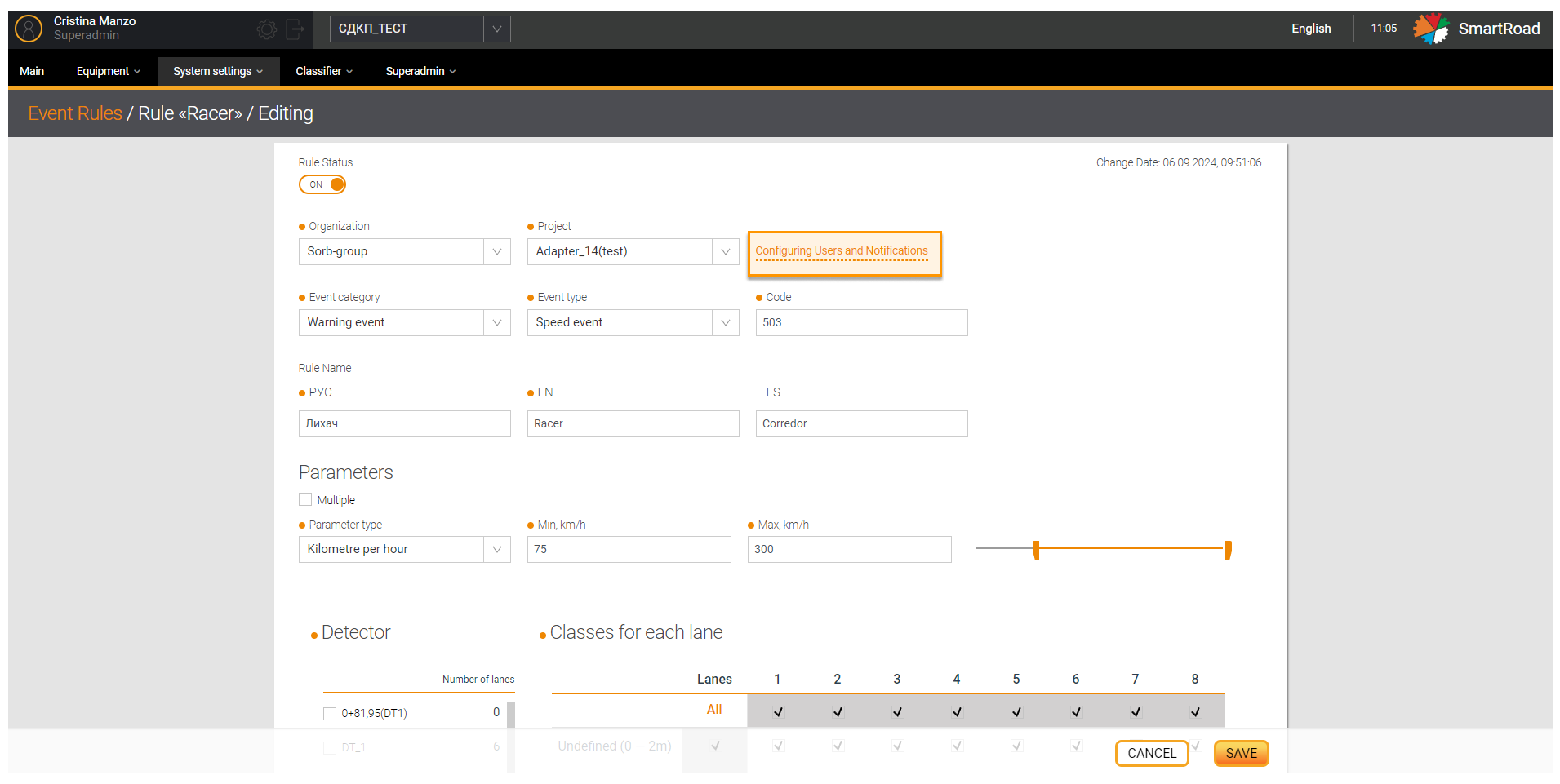
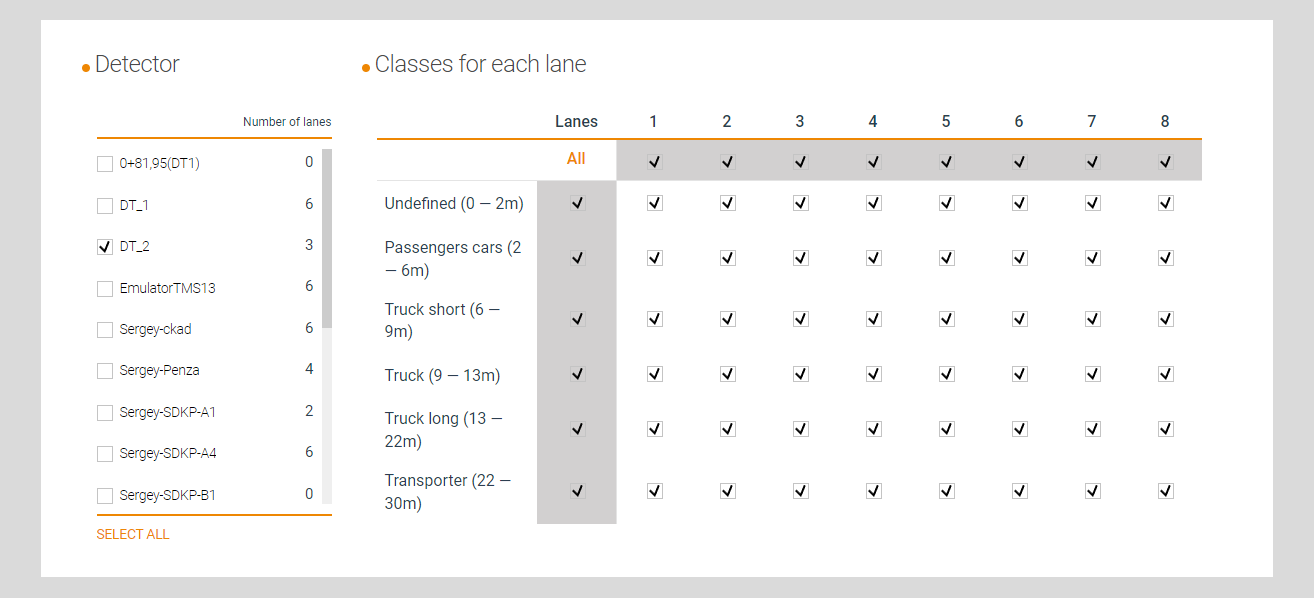
In the Rules editing window that opens, click on the button Setting up users and notifications. Afterward a pop-up window will appear with additional rule settings.
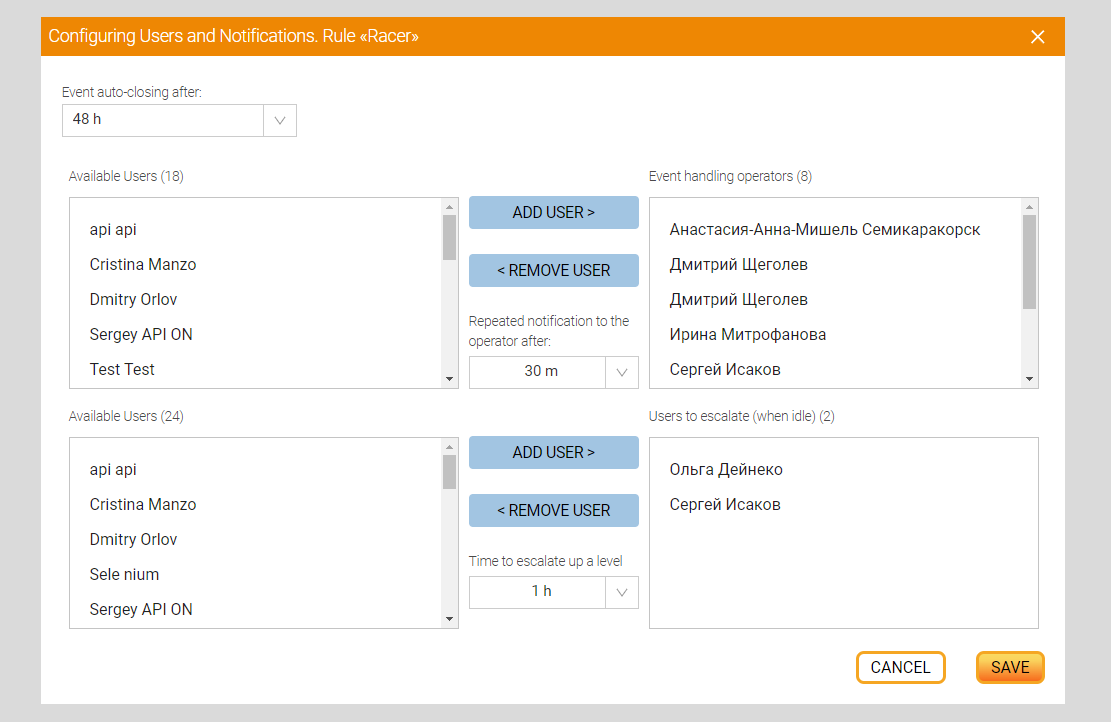
In the table below the options for Configuring users and Notifications are described.
| Field / button | Description |
|---|---|
| Auto-close via event | In the drop-down list, you can configure the time period for notifying about the closure of an event. |
| Available users | A field for selecting users already registered in the System by the superadmin to add them to the project for further work with it. Adding users to the project can be done by selecting the required user and clicking the button Add |
| Event Operators/Supervisors | The field displays the users (operators/managers) added to the rule |
| Add | Add an operator or manager to a rule |
| Put away | Removing users from a rule is done by selecting Event Processing Operators/Managers in the window and clicking the Remove button |
| Repeated notification (through operator) | In the drop-down list you can configure the period for re-notifying the operator |
| Notifying (through manager) | In the drop-down list you can configure the manager’s notification period |
| Cancel | Cancel changes made |
| Save | Save changes |
Delete and edit an event rule
You should hover the mouse cursor over the entry in the list and click on the edit button to change the rule parameters. When you click the button, the event rule editing page will open (similar to the rule adding window) with the previously specified parameters.
In case of removing a rule from the system, you must click on the delete button. When you click on this button, you must confirm the deletion in a pop-up window by clicking Delete or cancel deletion by pressing the button Cancel.